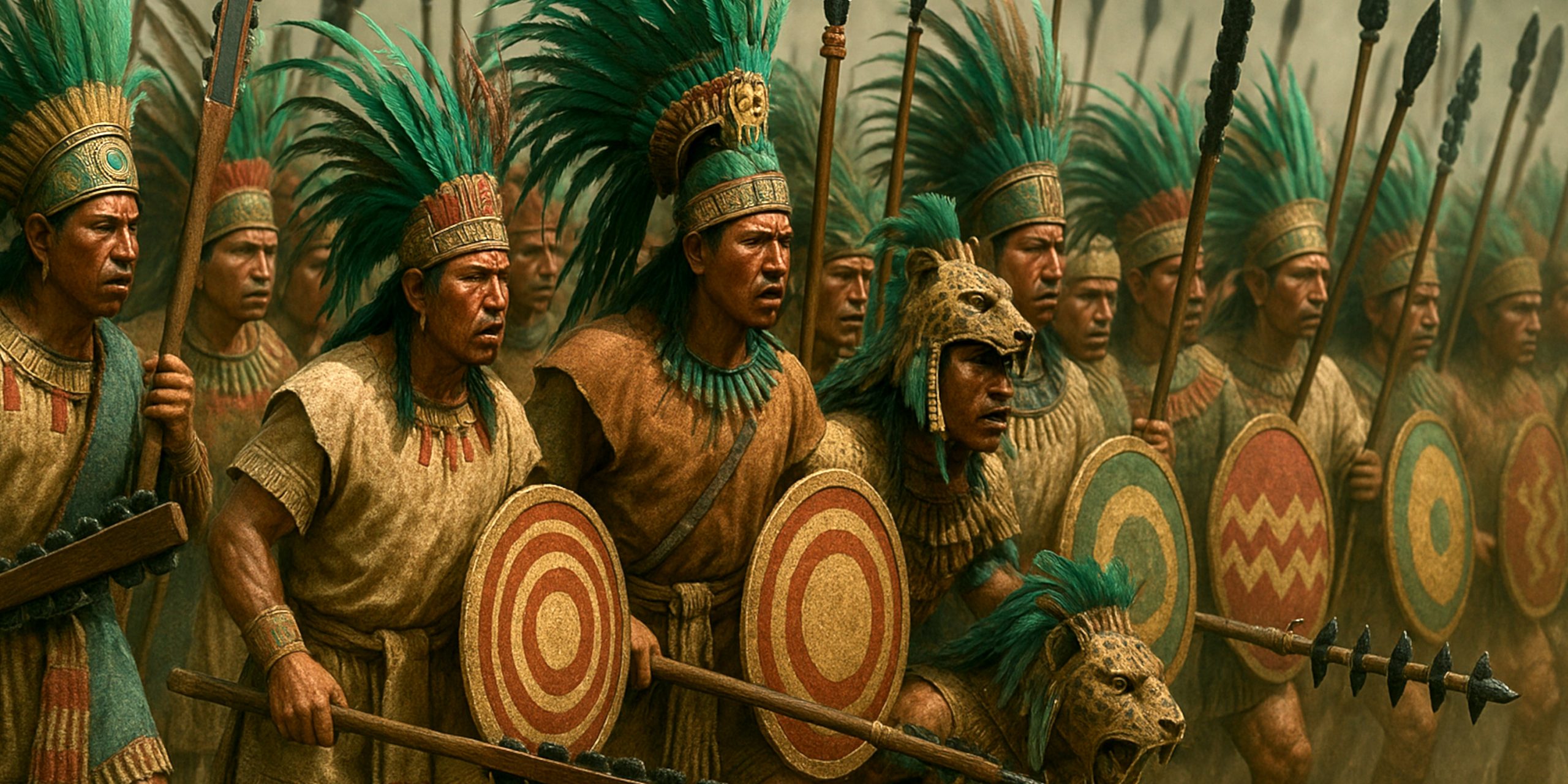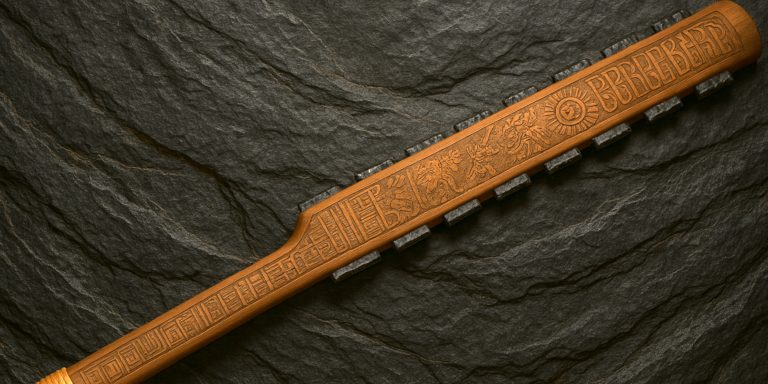
The Aztec Empire rose to power through conquest, diplomacy, and the disciplined military machine of Tenochtitlan. Their armies combined fierce strategy with religious purpose, waging wars to expand territory and capture enemies for ritual sacrifice. From early campaigns under Itzcoatl to the empire’s desperate final stand against Hernán Cortés, Aztec warfare shaped Mesoamerican history.
1. The Fall of Tenochtitlan (1521)
Summary:
The final and most catastrophic battle in Aztec history saw the mighty capital, Tenochtitlan, besieged by Spanish conquistadors under Hernán Cortés and their Tlaxcalan allies. After months of famine, disease, and brutal fighting across the city’s canals and causeways, the Aztec Empire collapsed.
Commanders:
- Aztec: Cuauhtémoc, last Huey Tlatoani
- Spanish: Hernán Cortés
- Allied: Tlaxcalan leaders Xicotencatl and Chichimecatecle
Troop Estimates:
- Aztec: Approx. 100,000 defenders
- Spanish and Allies: Around 1,000 Spaniards and 75,000–100,000 Tlaxcalan warriors
Weapons Used:
- Aztec: Macuahuitl (obsidian-edged sword), atlatl (spear-thrower), shields of woven cane
- Spanish: Steel swords, crossbows, firearms, cavalry, and brigantines
Outcome:
The city fell on 13 August 1521 after 93 days of siege. Cuauhtémoc was captured, marking the end of Aztec sovereignty.
Legacy:
This battle ended the Aztec Empire and began Spanish colonial rule in Mexico. It remains one of the most consequential sieges in world history for its cultural and demographic impact.
2. The Noche Triste (1520)
Summary:
After the killing of Emperor Moctezuma II and a rising revolt in Tenochtitlan, Cortés and his forces attempted to escape the city by night. The retreat became a bloodbath as Aztec warriors struck from canoes and rooftops, killing hundreds of Spaniards and thousands of Tlaxcalans.
Commanders:
- Aztec: Cuitláhuac
- Spanish: Hernán Cortés
Troop Estimates:
- Aztec: Approx. 50,000 warriors
- Spanish and Allies: Around 1,300 men and several thousand Tlaxcalans
Weapons Used:
- Aztec: Obsidian blades, darts, slings, and canoes for canal ambushes
- Spanish: Steel swords, crossbows, arquebuses, and cavalry
Outcome:
A devastating Aztec victory. Cortés lost much of his army and treasure but managed to regroup in Tlaxcala.
Legacy:
The Noche Triste became a symbol of Aztec resilience and Spanish desperation. Yet, it also marked the last major Aztec triumph before the empire’s downfall.
3. The Battle of Otumba (1520)
Summary:
Following their retreat from Tenochtitlan, Cortés and his remaining forces were pursued by a vast Aztec host to the plains of Otumba. In a desperate engagement, the Spaniards broke the Aztec line when Cortés personally struck down a leading standard-bearer, causing confusion among the enemy ranks.
Commanders:
- Aztec: Matlatzincatl
- Spanish: Hernán Cortés
Troop Estimates:
- Aztec: 40,000–100,000
- Spanish and Allies: Roughly 600 Spaniards and a few thousand Tlaxcalans
Weapons Used:
- Aztec: Macuahuitl, obsidian-tipped spears, shields
- Spanish: Steel arms, cavalry, and limited artillery
Outcome:
A Spanish victory achieved through shock tactics and superior weapons.
Legacy:
The battle preserved Cortés’s force and allowed him to regroup, making the eventual siege of Tenochtitlan possible.
4. The Conquest of Tlaxcala (1519)
Summary:
Before becoming Spanish allies, the Tlaxcalans fiercely resisted Cortés and his men. The conflict spanned multiple engagements over several days, marked by heavy casualties and brutal hand-to-hand fighting. The Spaniards’ survival impressed the Tlaxcalan council, leading to a crucial alliance.
Commanders:
- Tlaxcalan: Xicotencatl the Younger
- Spanish: Hernán Cortés
Troop Estimates:
- Tlaxcalan: Around 30,000 warriors
- Spanish: 400–500 soldiers
Weapons Used:
- Tlaxcalan: Wooden clubs, spears, and obsidian blades
- Spanish: Firearms, steel weapons, and cavalry
Outcome:
Spanish victory and alliance through diplomacy after initial hostilities.
Legacy:
The Tlaxcalans became indispensable allies, their warriors crucial to later Spanish victories over the Aztecs.
5. The Tepanec War (1427–1430)
Summary:
The Tepanec War marked the birth of the Aztec Triple Alliance. The city of Azcapotzalco, led by Maxtla, sought to crush Tenochtitlan. In response, Itzcoatl of the Mexica allied with Nezahualcoyotl of Texcoco and Totoquihuaztli of Tlacopan, defeating the Tepanec Empire and establishing the foundation of Aztec dominance.
Commanders:
- Tepanec: Maxtla
- Triple Alliance: Itzcoatl, Nezahualcoyotl, Totoquihuaztli
Troop Estimates:
- Tepanec: 40,000
- Triple Alliance: 50,000 combined
Weapons Used:
- Obsidian-edged weapons, spears, slings, and padded cotton armour
Outcome:
Victory for the Triple Alliance. Azcapotzalco was sacked, and the new coalition took control of the Valley of Mexico.
Legacy:
This war created the political structure that would dominate Mesoamerica for the next century. It marked the transformation of Tenochtitlan from a tributary city into an imperial capital.
6. The Conquest of Huexotzinco (1480s)
Summary:
One of several “Flower Wars” between the Aztecs and their rivals, the Huexotzinca, this campaign exemplified Aztec military culture. These ritualised battles were fought both for dominance and for captives to sacrifice to the gods.
Commanders:
- Aztec: Ahuitzotl (Huey Tlatoani)
- Huexotzinca: Unrecorded regional leaders
Troop Estimates:
- Both sides fielded between 20,000 and 40,000 warriors
Weapons Used:
- Macuahuitl, shields, feathered banners, and atlatl spears
Outcome:
Aztec victory and subjugation of Huexotzinco.
Legacy:
The conquest strengthened the empire’s grip on central Mexico and reinforced the social and religious function of warfare within Aztec society.
The Seven Swords Takeaway
The Aztec Empire’s history is written in blood and ambition. From the unification of the Valley of Mexico to its destruction by steel and disease, each battle tells of a civilisation that mastered warfare as both art and ritual. Though Tenochtitlan fell, the legacy of its warriors, strategy, and spirit continues to shape Mexican identity today.



